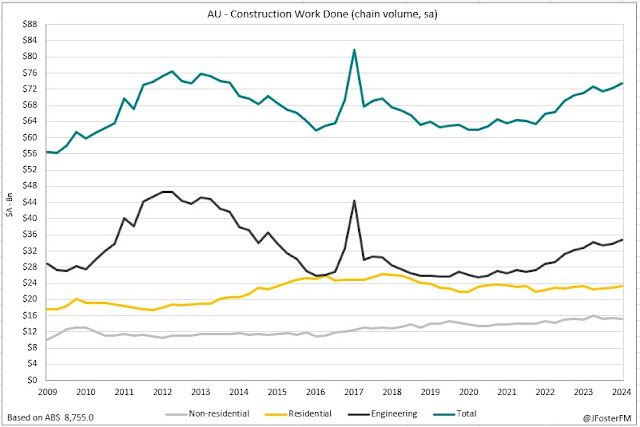RBA Governor Bullock reaffirmed the central bank's hawkish view of the rates outlook in Australia, highlighting that inflationary pressures are holding the Board back from easing monetary policy. Although encouraged by declining headline inflation - reported in the monthly indicator this week to be at a 2.1%yr pace in October, down from 4%yr in May (see here) - Governor Bullock said this has been expected due to the effects of government electricity rebates and lower fuel prices. The RBA is instead focused on underlying inflation that remains elevated to the 2-3% target band, a signal Governor Bullock maintained was consistent with demand exceeding supply.
Another key factor behind the RBA's reluctance to join the global easing cycle is that a cash rate of 4.35% is judged to be less restrictive than the stances of its central bank peers now cutting rates. Governor Bullock reiterated that the Board's strategy had been to gradually return inflation to target by raising rates less aggressively in order to protect the gains made in the labour market. In other RBA news, the Senate has passed legislation that will bring about major reforms to the board structure - separating its current responsibilities of monetary policy and operational matters across what will be two newly appointed boards - in changes that stem from the RBA Review handed to the Treasurer in March 2023.
Positive details for construction activity (1.6%) and capital expenditure (1.1%) in the September quarter were received ahead of next week's National Accounts. The Australian economy looks to have expanded by around 0.4% in Q3, an improvement from recent quarters as more encouraging dynamics emerged for household consumption. My detailed preview of the GDP report is available here.
In the US, the minutes of the Fed's November meeting noted that the Committee would consider pausing its easing cycle if the balance of risks to the outlook were to shift or if inflation remained elevated. Data this week showed that the Fed's preferred core PCE deflator posted a 0.3% rise in October - its fastest month-on-month rise since March - firming from 2.7% to 2.8% at an annual rate. The Committee is currently in the position of weighing up the risks of easing monetary policy too quickly - which could renew inflation pressures - against the risk of easing too slowly - which could damage growth and the labour market.
Weak growth into the risk of trade tariffs continues cloud the outlook for the export-oriented euro area economy. Pricing for a 50bps ECB rate cut in December had built up on these dynamics only to be pared back this week; euro area inflation lifted from 2% to 2.3%yr in November (as expected) while the core rate remained at 2.7%yr (vs 2.8%), while comments from ECB officials were also influential. ECB Chief Economist Lane said that in his view the euro area was in a 'cyclical recovery' phase; Executive Board member Schnabel pushed for a gradual approach to policy easing - highlighting monetary policy as an ineffective tool to address structural weaknesses that are weighing on growth; and ECB President Lagarde said it was too early to be conclusive on the inflationary and growth impacts tariffs may have. Taking a more dovish tone, the ECB's Villeroy said weak growth and the risk of inflation undershooting the 2% target could warrant rates being cut below neutral.










































